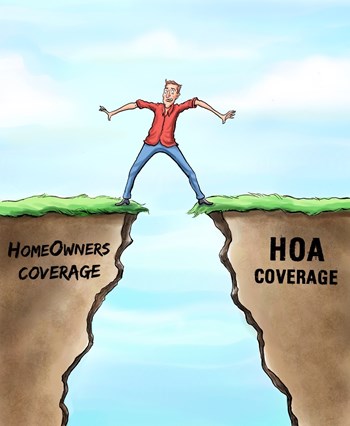
Insurance is designed to be there for us when we need it most. Without knowing the full extent of our coverage, though, we may find ourselves facing an emergency with less protection than we thought. For shareholders or unit owners, it is imperative to understand exactly what liabilities and risks are covered by individual resident homeowner policies and what is covered by the building’s policy. Unfortunately, many co-op and condo residents misinterpret who is responsible for what. Knowing exactly what is protected and by whose policies is imperative in ensuring that properties and possessions are in good hands should an emergency arise.
“Most unit owners do not have enough coverage for their unit as they are not properly advised,” says Lynn Delaney, branch manager at GFI Insurance Services in Monticello. “Co-op purchasers are often told by lenders that they do not need coverage as it is not required for the loan. Obviously whether it is required for a loan or not, they do need coverage for personal belongings and liability as well as building property coverage.”
Patti Berman, an insurance specialist at Masters Coverage Corp in Manhattan, adds, “A lot of residents feel that their units are covered by the building and do not feel that they have to get homeowner's insurance.”
Know Your Insurance
In order to avoid problems later, it is important for unit owners to learn as much as they can about their own policy, their building’s policies and where any gaps may exist.
“In a co-op or condo, you must first look at the proprietary lease or original offering plan which outlines where the building property stops and the personal property begins,” says Arthur Schwartz, senior vice president of Masters Coverage Corp.
“Policies written for co-ops or condo associations provide coverage for the common property as defined under the bylaws or proprietary lease,” adds Alex Seaman, a senior vice president at HUB International Northeast located in Woodbury. “This typically includes the building structure as originally constructed to the interior walls of the individual units—excluding paint or wallpaper. Any alterations to specific units by any occupant after the original construction becomes the personal property of the unit owner, which should then be insured under a homeowner’s policy as ‘Additions and Alterations’ coverage. This can include new hardwood floors, cabinetry, fixtures, as well as extensive interior renovations. It is not uncommon to insure the additions and alterations at well over $1,000,000.”
In general, a resident must insure their personal property as well as any changes they make to the unit, often referred to by insurance companies as improvements and betterments. “Once the unit owner or shareholder attaches something new to their unit, it becomes their property and the value of that has to be included in the improvements and betterments section of the homeowner's policy. Going from there, each person furnishes their unit differently and needs to estimate how much it would cost to replace or repair their property,” says Schwartz. He cites that clothing, window treatments, furniture are all considered personal property and need to be appraised and insured. To illustrate Schwartz says, “if you turn the apartment upside down, that which would fall down would be your personal property, that which would remain affixed, are the improvements and betterments.”
Because this process of appraisal can be tricky, “many insurance companies will go out and they will appraise the improvements and betterments to give people an idea of what they need to insure for, because for many it can be a difficult process,” says Berman.
With each policy being unique to the association, what will and will not be covered in the case of damage or catastrophe will be determined by the policy itself.
“The most common issue I see, is that if in a building, with units above and below, when a fire or any other covered peril starts in one unit and causes damage to other units, the units that got damaged think that the building’s insurance or the unit owner, where the accident happened would be responsible,” says Steve Principe, owner of The Principe Agency in East Meadow. “If the fire or covered peril is a one-time accident, each unit owner’s policy would cover their own unit’s damage. The building’s insurance would cover any damage that pertains to the building as per the bylaws. If the unit owner that caused the accident was determined to be negligent in some way, then all the units affected and the building carriers could try to subrogate and get reimbursed.”
He continues to say that “the building’s insurance would cover only damage to the building. They would also get covered for loss of rents or maintenance fees not paid by the unit owners, until the repairs were completed or when the unit owner could get back to living in the unit. The building is not responsible for relocating unit owners to other locations during the repairs, the unit owner's policy would cover that portion, known as loss of use.”
A Two-Way Street
When it comes to education about both the building and homeowner's policy, each respective party is responsible for knowing the insurance details.
“It is the responsibility of the board along with the managing agent to be sure that the building is properly insured. Usually, the management agreement defines the duty of the managing agent in the insurance process. I think each resident has a responsibility to know what the building policy covers and what their own homeowner’s policy should cover,” says Schwartz.
But, it is the responsibility of the unit owner to do their own investigating when it comes to specific insurance limits and adequate coverage amounts.
“The association is not responsible for advising each unit owner on what should be purchased outside of what the association requires them to carry. They may require a minimum limit of liability to be carried by each owner and ask for a copy of this policy each year but that various from building to building,” says Delaney.
Principe agrees, “I don’t think it would be mandatory [to educate the residents on building policy], but requiring the unit owners to have their own insurance benefits both the building and the unit owner. It is really the unit owner's responsibility to get the proper coverage from their individual insurance broker.”
Usually the bylaws will dictate if the resident can see the insurance policy of the building. “Generally speaking, if the unit owner or shareholder calls our office and asks for a copy of the building’s insurance, we will not send it to them directly unless we have approval from the managing agent or the board of directors,” says Schwartz.
Delaney suggests that, “the board should review the association policy annually or whenever there is a change in exposure. This being said it does not always happen and many times there is a gap in coverage. Most insurance companies under the HO-6 condo or HO-9 co-op form offer an endorsement for loss assessment coverage which can be purchased in increments of $1,000 up to $50,000. This covers the unit owner if they are assessed for a covered loss to the building which is not covered by the master policy or if the master policy just does not have sufficient coverage.”
Ensuring Coverage
It is not required by the state of New York to have homeowner's coverage, says Principe. But, most bylaws require that each unit owner or shareholder carry insurance and present a certificate of insurance to the managing agent, says Schwartz.
That being said, in her experience, Delaney says that insurance companies will not look more favorably on buildings in which more residents are covered by individual policies but she has “seen a carrier decline to insure any individual units in a specific building due to overall poor loss history through which is information available to them.”
Principe adds that, “lenders for the building are generally only concerned with coverage and carriers for the building. The lender will have certain requirements, based on their own appraisals and inspections. They will require the insurance carrier to be at least A rated or higher. Each year the bank will require renewal certificates of insurance and/or copies of the policies.”
When it comes to the things that matter to us most, insurance is imperative in protecting not only our homes and our possessions but our peace of mind.
“Many people are proud of their homes and the money they put into them but when it comes to insurance, they often underestimated the value of their belongings and property,” says Schwartz.
Knowing what is and is not covered and what we can do to make sure all bases are covered is absolutely key in being prepared for the rainiest of days.
Liz Lent is a freelance writer and a frequent contributor to The Cooperator. Editorial Assistant Maggie Puniewska contributed to this article.






Leave a Comment